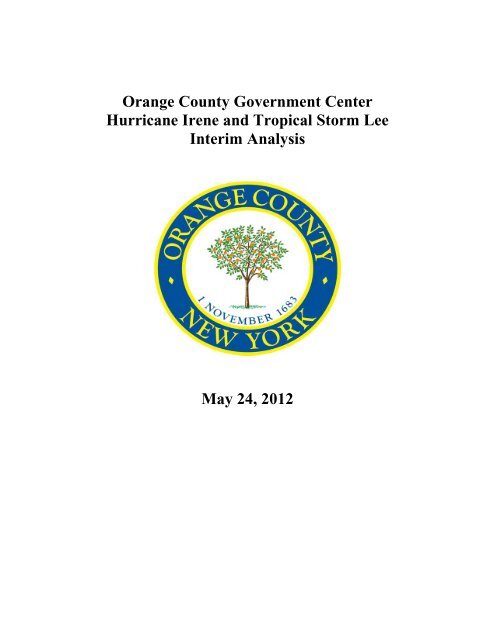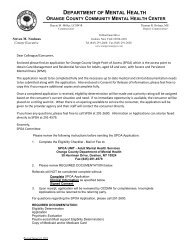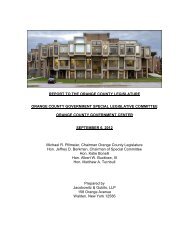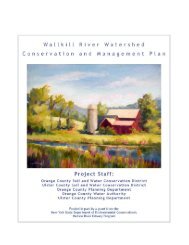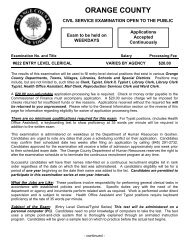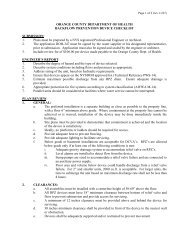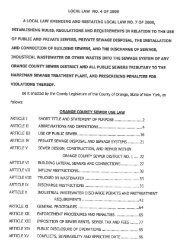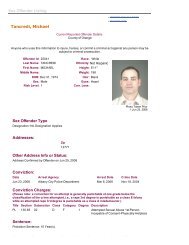Orange County Government Center Hurricane Irene and Tropical ...
Orange County Government Center Hurricane Irene and Tropical ...
Orange County Government Center Hurricane Irene and Tropical ...
Create successful ePaper yourself
Turn your PDF publications into a flip-book with our unique Google optimized e-Paper software.
<strong>Orange</strong> <strong>County</strong> <strong>Government</strong> <strong>Center</strong><br />
<strong>Hurricane</strong> <strong>Irene</strong> <strong>and</strong> <strong>Tropical</strong> Storm Lee<br />
Interim Analysis<br />
May 24, 2012
Table of Contents<br />
Executive Summary……………………………………………………………….3<br />
Introduction………………………………………………………………………..4<br />
<strong>Government</strong> <strong>Center</strong> History……………………………………………………….4<br />
Summary of <strong>Hurricane</strong> <strong>Irene</strong> <strong>and</strong> <strong>Tropical</strong> Storm Lee on <strong>Orange</strong> <strong>County</strong>………..4<br />
Timeline of <strong>Government</strong> <strong>Center</strong> Related Activities……………………………….6<br />
Previous Major Disaster Declarations……………………………………………..6<br />
Damage to the <strong>Government</strong> <strong>Center</strong>………………………………………………..7<br />
Damage to the <strong>Government</strong> <strong>Center</strong> Parking Lot…………………………..8<br />
Interior Flooding of the <strong>Government</strong> <strong>Center</strong>……………………………....8<br />
Damage Due to Water Infiltration…………………………………………10<br />
Masonry Walls……………………………………………………………..13<br />
Mold………………………………………………………………………..14<br />
Conclusion………………………………………………………………………….25<br />
2
Executive Summary<br />
On August 28 th 2011 <strong>Hurricane</strong> <strong>Irene</strong> made l<strong>and</strong>fall in New York. This hurricane was the<br />
most significant tropical event in the New York Metropolitan Area since 1999 with<br />
<strong>Hurricane</strong> Floyd. On September 6 th the remnants of <strong>Tropical</strong> Storm Lee impacted the<br />
New York Metropolitan Area.<br />
These two tropical storms significantly damaged the <strong>Orange</strong> <strong>County</strong> <strong>Government</strong> <strong>Center</strong>.<br />
Since 1970, <strong>Orange</strong> <strong>County</strong> has been included in thirteen Federal Major Disaster<br />
Declarations related to flooding <strong>and</strong> heavy rain. Only in 1996 <strong>and</strong> 1999 (<strong>Hurricane</strong><br />
Floyd) has <strong>Orange</strong> <strong>County</strong> submitted for Public Assistance under the Stafford Act for<br />
damages done to the <strong>Government</strong> <strong>Center</strong>. During these events the <strong>Government</strong> <strong>Center</strong><br />
experienced flooding to the first floor level. The roofing system was never claimed nor<br />
had any resulting damage from its failure.<br />
Not until the arrival of <strong>Hurricane</strong> <strong>Irene</strong> <strong>and</strong> <strong>Tropical</strong> Storm Lee did the roofing system of<br />
the <strong>Government</strong> <strong>Center</strong> fail so completely. This failure led to the infiltration of<br />
significant amounts of water in areas <strong>and</strong> in quantities never seen before in the history of<br />
the building.<br />
The infiltration of water from the failed roofing system, the flooding of the first floor<br />
level <strong>and</strong> the damage to the switchgear led to a proliferation of mold growth in the<br />
building. The widespread presence of mold was the main causation for the indefinite<br />
closure of the <strong>Government</strong> <strong>Center</strong> <strong>and</strong> is directly related to <strong>Hurricane</strong> <strong>Irene</strong> <strong>and</strong> <strong>Tropical</strong><br />
Storm Lee.<br />
It is the contention of <strong>Orange</strong> <strong>County</strong> that the <strong>Government</strong> <strong>Center</strong> is not a healthy work<br />
environment <strong>and</strong> this building will not be reoccupied until such time that a<br />
comprehensive remediation <strong>and</strong> rehabilitation of the facility occurs.<br />
3
I. Introduction<br />
On August 28 th <strong>Hurricane</strong> <strong>Irene</strong> made l<strong>and</strong>fall in New York. This hurricane was the most<br />
significant tropical event in the New York Metropolitan Area since 1999. On September<br />
6 th the remnants of <strong>Tropical</strong> Storm Lee impacted the New York Metropolitan Area.<br />
<strong>Hurricane</strong> <strong>Irene</strong> <strong>and</strong> <strong>Tropical</strong> Storm Lee brought upwards of sixteen inches of rain into<br />
this region <strong>and</strong> together these storms are on track to be the most expensive natural<br />
disaster in the history of New York State. Current estimates of damage to public<br />
infrastructure <strong>and</strong> other emergency related costs for all the governments in <strong>Orange</strong><br />
<strong>County</strong> may exceed $55,000,000.<br />
The <strong>Orange</strong> <strong>County</strong> <strong>Government</strong> <strong>Center</strong>, located at 255 Main Street in the Village of<br />
Goshen, was one of many public buildings damaged in New York State. The<br />
<strong>Government</strong> <strong>Center</strong> was evacuated on August 29, 2011 due to flooding from <strong>Hurricane</strong><br />
<strong>Irene</strong> <strong>and</strong> a lack of electrical power. On September 6, 2011 the <strong>Government</strong> <strong>Center</strong> was<br />
reopened after an extensive cleaning <strong>and</strong> repairs to critical systems. On September 8,<br />
2011 the <strong>Government</strong> <strong>Center</strong> was closed indefinitely, again due to flooding from <strong>Tropical</strong><br />
Storm Lee <strong>and</strong> the visible presence of mold in the building.<br />
<strong>Orange</strong> <strong>County</strong> acknowledges that the <strong>Government</strong> <strong>Center</strong> was in need of repair in some<br />
areas, but the <strong>County</strong> <strong>and</strong> its consultants have determined that the building suffered<br />
significant damage resulting from <strong>Hurricane</strong> <strong>Irene</strong> <strong>and</strong> <strong>Tropical</strong> Storm Lee.<br />
II. <strong>Government</strong> <strong>Center</strong> History<br />
The <strong>Orange</strong> <strong>County</strong> <strong>Government</strong> <strong>Center</strong> was constructed in 1970.<br />
“The existing building superstructure consists of reinforced concrete columns with<br />
elevated reinforced concrete floor <strong>and</strong> roof slabs <strong>and</strong> integral concrete beams. Floor slabs<br />
utilize reinforced concrete cantilever construction at the building perimeter.” (Labella 1-<br />
7)<br />
In 1992 the <strong>Government</strong> <strong>Center</strong> underwent renovation in which the cantilevers were<br />
removed <strong>and</strong> renovations were completed.<br />
In 1985 <strong>and</strong> again in the 1990s extensive work was completed on the roof of the<br />
<strong>Government</strong> <strong>Center</strong>.<br />
There are no records of hazard mitigation funding being utilized on this property.<br />
III. Summary of the Impacts of <strong>Hurricane</strong> <strong>Irene</strong> <strong>and</strong> <strong>Tropical</strong> Storm Lee on <strong>Orange</strong><br />
<strong>County</strong><br />
A. <strong>Hurricane</strong> <strong>Irene</strong><br />
On the night of August 27 th <strong>and</strong> into the morning of August 28 th <strong>Hurricane</strong> <strong>Irene</strong><br />
made l<strong>and</strong>fall in New York State. This was the most significant tropical storm<br />
event to impact the region since <strong>Hurricane</strong> Floyd in 1999.<br />
4
The most significant flooding was experienced in the eastern portions of the<br />
<strong>County</strong> where nearly twelve inches of rain fell as a result of <strong>Hurricane</strong> <strong>Irene</strong>.<br />
<strong>Hurricane</strong> <strong>Irene</strong> caused the closure of nearly two hundred roads, damaged<br />
hundreds of homes, thous<strong>and</strong>s of acres of crops, caused two dams to fail <strong>and</strong><br />
forced hundreds of residents to seek emergency shelter.<br />
Location Storm Total Time of<br />
Date of<br />
Source<br />
Rainfall (inches) Measurement Measurement<br />
Tuxedo Park 11.48 1000 8/28 Public<br />
Harriman 10.45 1500 8/28 Skywarn Spotter<br />
Cornwall-on-Hudson 8.15 1120 8/28 Skywarn Spotter<br />
Montgomery 6.65 1400 8/28 <strong>Orange</strong> <strong>County</strong><br />
Airport<br />
New Windsor 6.25 1300 8/28 Skywarn Spotter<br />
Warwick 5.90 0650 8/28 Skywarn Spotter<br />
Newburgh 4.85 0745 8/28 Public<br />
Port Jervis 4.00 0630 8/28 Skywarn Spotter<br />
Table 1: National Weather Service Rainfall Observations during <strong>Hurricane</strong> <strong>Irene</strong><br />
B. <strong>Tropical</strong> Storm Lee<br />
On September 6 th the remnants of <strong>Tropical</strong> Storm Lee impacted <strong>Orange</strong> <strong>County</strong><br />
<strong>and</strong> caused additional flooding <strong>and</strong> damage to an already weakened public<br />
infrastructure system.<br />
The Wallkill River basin in the central portion of the <strong>County</strong> received its most<br />
significant flooding as a result of this event. <strong>Tropical</strong> Storm Lee exasperated<br />
Wallkill River flooding already occurring from <strong>Hurricane</strong> <strong>Irene</strong>.<br />
Location Storm Total Time of<br />
Date of<br />
Source<br />
Rainfall (inches) Measurement Measurement<br />
Warwick 8.30 2100 9/08 Skywarn Spotter<br />
Montgomery 8.21 1400 9/08 <strong>Orange</strong> <strong>County</strong><br />
Airport<br />
Chester 7.71 1300 9/08 Public<br />
Middletown 7.20 0800 9/08 Skywarn Spotter<br />
Harriman 7.20 2000 9/08 Skywarn Spotter<br />
Sterling Forest 7.15 2000 9/08 MESONET Weather<br />
Station<br />
New Windsor 6.29 1100 9/08 Skywarn Spotter<br />
Newburgh 6.24 1050 9/08 Skywarn Spotter<br />
Vails Gate 5.98 2129 9/08 Skywarn Spotter<br />
Port Jervis 4.56 0800 9/09 NWS Cooperative<br />
Observer<br />
Table 2: National Weather Service Rainfall Observations during <strong>Tropical</strong> Storm<br />
Lee<br />
5
IV. Timeline of <strong>Government</strong> <strong>Center</strong> Related Activities<br />
Event<br />
Date<br />
<strong>Hurricane</strong> <strong>Irene</strong> makes l<strong>and</strong>fall in New York State 8/28/11<br />
The <strong>Orange</strong> <strong>County</strong> <strong>Government</strong> <strong>Center</strong> is closed 8/29/11<br />
Major Disaster declared by the Federal <strong>Government</strong> (DR-4020) for <strong>Hurricane</strong> <strong>Irene</strong> 8/31/11<br />
Preliminary Damage Assessment for <strong>Hurricane</strong> <strong>Irene</strong> 9/1/11<br />
The <strong>Orange</strong> <strong>County</strong> <strong>Government</strong> <strong>Center</strong> reopens 9/6/11<br />
<strong>Tropical</strong> Storm Lee l<strong>and</strong>fall in New York State 9/8/11<br />
The <strong>Orange</strong> <strong>County</strong> <strong>Government</strong> <strong>Center</strong> is closed indefinitely 9/8/11<br />
Major Disaster declared by the Federal <strong>Government</strong> (DR-4031) for <strong>Tropical</strong> Storm 9/13/11<br />
Lee<br />
Labella <strong>and</strong> Associates performed a visual inspection of the <strong>Government</strong> <strong>Center</strong> 9/30/11<br />
Labella <strong>and</strong> Associates performed a visual inspection of the <strong>Government</strong> <strong>Center</strong> 10/7/11<br />
<strong>Hurricane</strong> <strong>Irene</strong> Kick Off Meeting with FEMA 10/28/11<br />
<strong>Tropical</strong> Storm Lee Kick Off Meeting with FEMA 11/18/11<br />
FEMA Building Assessment Team Inspects the <strong>Government</strong> <strong>Center</strong> 1/19,<br />
1/20,1/21,1/26,1/27,<br />
1/31/12<br />
FEMA Building Assessment Team meets with <strong>Orange</strong> <strong>County</strong> to discuss their<br />
2/9/12<br />
preliminary findings on the <strong>Government</strong> <strong>Center</strong><br />
<strong>Orange</strong> <strong>County</strong> receives a written draft of the FEMA Building Assessment Team’s 3/1/12<br />
report<br />
FEMA Building Assessment Team’s report distributed to <strong>Orange</strong> <strong>County</strong> Officials 3/8/12<br />
at the weekly recovery meeting<br />
Meeting with EMS-NY to present the FEMA Building Assessment Team’s mold 3/14/12<br />
report <strong>and</strong> request their assistance in evaluating <strong>and</strong> responding to the report<br />
Meeting with building specialists to present the FEMA Building Assessment<br />
3/19/12<br />
Team’s <strong>Government</strong> <strong>Center</strong> report <strong>and</strong> request their assistance in evaluating <strong>and</strong><br />
responding to the report<br />
Invitations were sent to <strong>Orange</strong> <strong>County</strong>, New York State Office of Emergency 4/30/12<br />
Management <strong>and</strong> FEMA to meet in order to reconcile <strong>Orange</strong> <strong>County</strong>’s storm<br />
related damage assessment <strong>and</strong> FEMA’s assessment<br />
FEMA Building Assessment Team Inspects the <strong>Government</strong> <strong>Center</strong> 5/4/12<br />
<strong>Orange</strong> <strong>County</strong> meets with its consultants to discuss their findings in response to 5/4/12<br />
the FEMA Building Assessment Team’s report<br />
<strong>Orange</strong> <strong>County</strong>, New York State Office of Emergency Management <strong>and</strong> FEMA 5/9/12<br />
meet to reconcile <strong>Orange</strong> <strong>County</strong>’s storm related damage assessment <strong>and</strong> FEMA’s<br />
assessment<br />
The FEMA Critical Infrastructure Team notifies <strong>Orange</strong> <strong>County</strong> that a revised PW 5/17/12<br />
for the <strong>Government</strong> is complete<br />
<strong>Orange</strong> <strong>County</strong> picked up the <strong>Government</strong> <strong>Center</strong> PW at the Joint Field Office in 5/23/12<br />
Albany<br />
Table 3: Significant <strong>Government</strong> <strong>Center</strong> Related Activities<br />
V. Previous Major Disaster Declarations<br />
Since the construction of the <strong>Orange</strong> <strong>County</strong> <strong>Government</strong> <strong>Center</strong> in 1970, <strong>Orange</strong> <strong>County</strong><br />
has been included in thirteen Major Disaster Declarations involving rain related incidents<br />
including flooding, severe storms, tropical storms <strong>and</strong> coastal storms. Each of these<br />
events brought a significant level of rainfall <strong>and</strong> flooding to <strong>Orange</strong> <strong>County</strong>.<br />
6
Incident FEMA Designation Number Declaration Date<br />
Severe Storms, Flooding FEMA-DR-311 New York September 13, 1971<br />
<strong>Tropical</strong> Storm Agnes FEMA-DR-338 New York June 23, 1972<br />
Coastal Storms, Flooding FEMA-DR-702 New York April, 17, 1984<br />
Severe Storms, Flooding FEMA-DR-1095 New York January 24, 1996<br />
<strong>Hurricane</strong> Floyd FEMA-DR-1296 New York September 19, 1999<br />
Severe Storms, Flooding FEMA-DR-1564 New York October 1, 2004<br />
<strong>Tropical</strong> Depression Ivan FEMA-DR-1565 New York October 1, 2004<br />
Severe Storms, Flooding FEMA-DR-1589 New York April 19, 2005<br />
Severe Storms, Flooding FEMA-DR-1650 New York July 1, 2006<br />
Severe Storms <strong>and</strong> Inl<strong>and</strong> <strong>and</strong> FEMA-DR-1692 New York April 24, 2007<br />
Coastal Flooding<br />
Severe Storms, Flooding FEMA-DR-1899 New York April 16, 2010<br />
<strong>Hurricane</strong> <strong>Irene</strong> FEMA-DR-4020 New York August 31, 2011<br />
Remnants of <strong>Tropical</strong> Storm Lee FEMA-DR-4031 New York September 13, 2011<br />
Table 4: Federal Disaster Declarations that Include <strong>Orange</strong> <strong>County</strong><br />
Of the thirteen flood related Disaster Declarations since 1970, 61% occurred within the<br />
last ten years.<br />
Out of these thirteen flood related Disaster Declarations since 1970, <strong>Orange</strong> <strong>County</strong><br />
submitted for Public Assistance funding for damages sustained to the <strong>Government</strong> <strong>Center</strong><br />
twice.<br />
In 1996 (DR-1095) heavy rain flooded the parking lot of the <strong>Government</strong> <strong>Center</strong> <strong>and</strong><br />
water infiltrated the Electrical Room <strong>and</strong> the Generator Room.<br />
In 1999 <strong>Hurricane</strong> Floyd (DR-1296) again flooded the parking lot the <strong>Government</strong> <strong>Center</strong><br />
<strong>and</strong> water infiltrated the Electrical Room <strong>and</strong> the Generator Room.<br />
There is no record of significant damage relating to the roofs or water infiltration on the<br />
second or third floors of the <strong>Government</strong> <strong>Center</strong>.<br />
The <strong>Orange</strong> <strong>County</strong> <strong>Government</strong> <strong>Center</strong> has never been closed due to storm related<br />
damage in its history prior to the arrival of <strong>Hurricane</strong> <strong>Irene</strong>.<br />
No hazard mitigation funding, under Section 406 of the Stafford Act, was submitted for<br />
relating to the <strong>Government</strong> <strong>Center</strong> for these declared disasters.<br />
VI. Damage to the <strong>Government</strong> <strong>Center</strong><br />
<strong>Hurricane</strong> <strong>Irene</strong> <strong>and</strong> <strong>Tropical</strong> Storm Lee brought large amounts of water over a short<br />
period of time to the Goshen Area. These storms, combined with numerous other rain<br />
events in August 2011, caused a significant quantity of water to enter the <strong>Government</strong><br />
<strong>Center</strong>. The sources of this water infiltration came in two forms. The first source being<br />
overl<strong>and</strong> flood waters <strong>and</strong> high ground water entering the first floor level of the<br />
<strong>Government</strong> <strong>Center</strong>. The second source was water infiltrating from the roofing system<br />
causing water damage to the second <strong>and</strong> third floors.<br />
7
A. Damage due to Flooding<br />
1. Damage to the <strong>Government</strong> <strong>Center</strong> Parking Lot<br />
As during the 1996 declared disaster <strong>and</strong> <strong>Hurricane</strong> Floyd in 1999, the<br />
parking lot of the <strong>Government</strong> <strong>Center</strong> became inundated with rainwater<br />
<strong>and</strong> water from the overflowing drainage ditches during both <strong>Hurricane</strong><br />
<strong>Irene</strong> <strong>and</strong> <strong>Tropical</strong> Storm Lee.<br />
“The existing drainage channels through the property, which together form<br />
a branch of the Rio Gr<strong>and</strong>e Creek, quickly reached bank-full capacity at<br />
the beginning of each storm.” (Labella 1-4)<br />
The terrain surrounding the <strong>Government</strong> <strong>Center</strong> also was a factor in the<br />
flooding of the property. “The existing (<strong>Government</strong> <strong>Center</strong>) drainage<br />
system was overwhelmed from other adjoining Goshen neighborhood<br />
hillside drainage systems. All four sides of this complex received water<br />
from neighboring systems.” (<strong>Government</strong> <strong>Center</strong> Grounds 1)<br />
This flooding may have caused additional damage to the parking lot<br />
already rated by Labella as fair to poor prior to the storm. According to<br />
Labella, “the most likely cause of the new cracks is heaving <strong>and</strong><br />
settlement of the pavement subbase, caused by the flooding <strong>and</strong> the<br />
subsequent draining of the site. (Labella 1-5)<br />
2. Interior Flooding of the <strong>Government</strong> <strong>Center</strong><br />
As with the storms of 1996 <strong>and</strong> 1999, water entered the <strong>Government</strong><br />
<strong>Center</strong> due to overl<strong>and</strong> flooding on the Northwestern portion of the<br />
property.<br />
“The existing building ground floor elevations at grade <strong>and</strong> volume during<br />
the flood from the adjacent creek caused the flooding of the below grade<br />
service spaces.” (Architectural Building Inspection Assessment <strong>and</strong><br />
Report 8)<br />
The floodwaters from the parking lot <strong>and</strong> high groundwater entered the<br />
building in principally two locations. The first areas of flooding were the<br />
mechanical rooms near the parking lot on the first floor level. The second<br />
areas to be flooded were the rooms under which a sub-slab trench ran<br />
along the first floor level.<br />
The floodwaters entered the building <strong>and</strong> flooded the Main Mechanical<br />
Room, the former Civil Defense Mechanical Room, <strong>and</strong> the Electrical<br />
Switchboard Room.<br />
8
The Main Mechanical Room <strong>and</strong> the former Civil Defense Mechanical<br />
Room were flooded with approximately four inches of water. The<br />
Electrical Switchboard Room is a sunken room <strong>and</strong> this area flooded with<br />
approximately forty inches of water. “Flood water reached a level of 40”<br />
in Room #416 damaging a 600 amp <strong>and</strong> 400 amp fused switch insert in the<br />
main 4000 amp switch board.” (Rosher 3)<br />
Picture 1: High Water Mark in the Electrical Switch Room<br />
When the Electrical Switchboard Room was flooded, the switchgear<br />
system was damaged preventing electrical power from the grid or the<br />
emergency generators from operating the <strong>Government</strong> <strong>Center</strong>. “As a<br />
result, ventilation systems could not operate, <strong>and</strong> the existing fixed<br />
windows could not ventilate the building. This precondition created the<br />
ideal interior environment for the propagation of mold growth within the<br />
building.” (Labella 1-3)<br />
The second area of flooding on the first floor level of the <strong>Government</strong><br />
<strong>Center</strong> occurred due to a high water table caused by the heavy rain of<br />
<strong>Hurricane</strong> <strong>Irene</strong> <strong>and</strong> <strong>Tropical</strong> Storm Lee as well as the rain storms of the<br />
previous weeks.<br />
Water from the high water table entered the sub-slab pipe trench at the<br />
first floor level. Water backed up in this trench <strong>and</strong> caused the saturation<br />
of carpeting on the first floor. The water table was so high that for weeks<br />
after the storms had passed, water continued to infiltrate this trench system<br />
<strong>and</strong> pumps had to be utilized to keep the water at bay.<br />
9
Picture 2: Sump Pump on the First Floor Level Still Operating on 9/12/11<br />
B. Damage due to Water Infiltration<br />
During <strong>Hurricane</strong> <strong>Irene</strong> <strong>and</strong> <strong>Tropical</strong> Storm Lee a large quantity of rain water was<br />
deposited on the roofing system of the <strong>Government</strong> <strong>Center</strong>. “The extreme<br />
weather events of tropical storms <strong>Irene</strong> on August 28, 2011 <strong>and</strong> Lee on September<br />
5, 6, 7, <strong>and</strong> 8 produced large amounts of water <strong>and</strong> wind in rapid secession on the<br />
building structure <strong>and</strong> site overwhelming the existing building envelope,<br />
especially the roof.” (Architectural Building Inspection Assessment <strong>and</strong> Report 3)<br />
According to Labella Associates, this roofing system failed during both storms.<br />
Compounding the flood water problems at the base of the<br />
building complex was a large scale roofing system failure<br />
in many locations all throughout the building complex at<br />
the third floor level. Due to the quantity of rainfall, in a<br />
very short period of time, the existing roof drainage system<br />
could not h<strong>and</strong>le the volume of water on the existing roof<br />
system. Hydrostatic pressure forced water down through<br />
the roofing system <strong>and</strong> the existing building structure,<br />
causing damage to the existing interior systems <strong>and</strong><br />
finishes. (Labella 1-4)<br />
The roofing system of the <strong>Government</strong> <strong>Center</strong> consists of a single ply roof<br />
membrane which is ballasted with concrete masonry pavers. “The existing<br />
concrete unit masonry pavers have deteriorated over time, due to the freeze thaw<br />
cycle on the roof <strong>and</strong> a lack of adequate roof drainage system. Existing pavers<br />
have deteriorated to masonry dust in several locations.” (Labella 1-9)<br />
The Federal Emergency Management Agency Building Assessment Team<br />
(FEMA BAT) state “The visual inspection (of the roof) revealed that the storms<br />
did not compromise the existing structural systems <strong>and</strong> the roof is in basically the<br />
same condition as it was prior to the storms.” (Architectural Building Inspection<br />
Assessment <strong>and</strong> Report 4)<br />
10
<strong>Orange</strong> <strong>County</strong> <strong>and</strong> Labella Associates acknowledge that the roofing system had<br />
significant issues, but the roofing system had proved to be sufficiently adequate to<br />
weather eleven previously declared disasters as well as countless other hazardous<br />
weather events. This is the first time <strong>Orange</strong> <strong>County</strong> is seeking public assistance<br />
funding in the repair of the roofing system. <strong>Orange</strong> <strong>County</strong> contends that the<br />
massive amount of water received due to these storms overwhelmed the roofing<br />
system <strong>and</strong> not only exacerbated existing problems but also caused substantial<br />
new damage within the building.<br />
Picture 3: Interior Water Infiltration<br />
Evidence of water penetration is documented on the third floor of each of the<br />
three divisions of the <strong>Government</strong> <strong>Center</strong> as well as water penetration to the open<br />
areas of the second floor where this floor rises through the third floor to the roof<br />
deck.<br />
Picture 4: Water Damage to Carpeting<br />
The evidence of this water penetration mainly takes the form of stained <strong>and</strong> wet<br />
carpet, damaged gypsum board in the ceiling, damaged ceiling panels, <strong>and</strong> water<br />
stained walls <strong>and</strong> partitions.<br />
11
Picture 5: Water Damage to the Former Emergency Operations <strong>Center</strong><br />
“The existing roofing system appears to have sustained further damage as a result<br />
of the subject storm events by providing additional membrane failures as a result<br />
of sustained hydrostatic pressure from the subject storm events.” (Labella 1-10)<br />
The existing roof drainage system of the <strong>Government</strong> <strong>Center</strong> was inadequate to<br />
effectively remove the large volume of water brought by these storms. This lack<br />
of adequate drainage may have caused significant downward hydrostatic pressure<br />
due to the weight of the large amount of st<strong>and</strong>ing water on the roofing system.<br />
The existing roof drainage system does not have a<br />
secondary means of overflow roof drainage. Due to the<br />
volume <strong>and</strong> height of water that accumulated in a relatively<br />
short period of time, the design of the existing roof<br />
drainage system, <strong>and</strong> the existing conditions (deteriorated<br />
concrete masonry unit pavers) impeding roof drainage, the<br />
existing roof drainage system could not drain the volume of<br />
water on the subject roof to the point of the water spilling<br />
over the roof edge in many locations. Hydrostatic pressure<br />
forced water down through the existing roofing system,<br />
through the construction joints <strong>and</strong> existing cracks in the<br />
existing reinforced concrete roof deck. (Labella 1-10)<br />
Post storm investigation of the roofing system indicates that the drainage<br />
system failure was due to several factors.<br />
1. The drainage pipes on the roofing system of the <strong>Government</strong><br />
<strong>Center</strong> are inadequate to drain large volumes of water off the roofs.<br />
A building of this size constructed today would have four inch<br />
drains. A number of the drains are much smaller than four inches<br />
on the <strong>Government</strong> <strong>Center</strong>, some drains are as small two <strong>and</strong> half<br />
inches.<br />
2. Some of roofing system drains on the <strong>Government</strong> <strong>Center</strong> flow<br />
into the Rio Gr<strong>and</strong>e Creek. As that creek overflowed its banks due<br />
12
to heavy rain, the water backed up the drains <strong>and</strong> prevented any<br />
water to flow off the roofs as it was designed.<br />
Instead, the water collected on the roofs <strong>and</strong> created significant<br />
downward hydrostatic pressure. Water also was forced over the<br />
parapets of roofs <strong>and</strong> flowed down the sides of the building.<br />
3. As noted earlier, many of the concrete masonry unit pavers had<br />
deteriorated on the roofs but still served as adequate ballast. The<br />
water that had backed up on the roofing system caused some<br />
movement of the ballast on some of the individual roofs. In<br />
several locations this ballast became lodged in the drainage system,<br />
further restricting the flow of water off the roofing system.<br />
The evidence of the failure of the roofing system could be seen in the black stains<br />
that appeared on the exterior masonry walls of the <strong>Government</strong> <strong>Center</strong> after<br />
<strong>Hurricane</strong> <strong>Irene</strong> <strong>and</strong> <strong>Tropical</strong> Storm Lee. This black staining was from the dye<br />
contained in the roofing ballast. “As a result during the storm or a large rain<br />
event the saturated roof flood(s) over the cap flashing, down the fascia <strong>and</strong> the<br />
dye from the block is leached out <strong>and</strong> drips down the exterior wall indicating the<br />
black stain is a result of the overflow” (Architectural Building Inspection<br />
Assessment <strong>and</strong> Report 4)<br />
Picture 6: Exterior Staining of the Building<br />
According to personnel in the <strong>Orange</strong> <strong>County</strong> Department of Public<br />
Works assigned to the <strong>Government</strong> <strong>Center</strong>, they witnessed water<br />
infiltrating into the building in locations never before observed prior to the<br />
arrival of <strong>Hurricane</strong> <strong>Irene</strong> <strong>and</strong> <strong>Tropical</strong> Storm Lee. These employees also<br />
witnessed water entering the building in quantities never before observed.<br />
Combined, these employees have decades of experience in maintaining the<br />
<strong>Government</strong> <strong>Center</strong> <strong>and</strong> are intimately familiar with the building.<br />
C. Masonry Walls<br />
The masonry walls of the <strong>Government</strong> <strong>Center</strong> were constructed with a<br />
split rib masonry veneer. This veneer appears to have become saturated in<br />
some locations due to the absorption of water during the storms.<br />
13
It appears that moisture has penetrated the masonry in some<br />
locations, through the joints between the split rib veneer<br />
<strong>and</strong> the reinforced concrete frame. This is evident on the<br />
building exterior <strong>and</strong> interior…Water penetrates by air<br />
pressure differential between the building interior <strong>and</strong> the<br />
exterior. In this instance, water literally is sucked inside of<br />
the existing building. The existing masonry building<br />
envelope appears to have sustained further damage as a<br />
result of the subject storm events by absorbing additional<br />
moisture as a result of wind driven rain <strong>and</strong> differential air<br />
pressure (building exterior to interior) from the subject<br />
storm events. (Labella 1-11)<br />
D. Mold<br />
Due to the flooding of the Electrical Switchboard Room on August 28 th , all<br />
electrical power was suspended to the <strong>Government</strong> <strong>Center</strong>. The flooding of the<br />
switchgear acted as a single point of failure <strong>and</strong> prevented the delivery of<br />
electrical power from the grid or the emergency generator.<br />
The lack of electrical power prevented the operation of the ventilation system.<br />
“Due to the quantity of water inside the building, <strong>and</strong> the inability of the<br />
mechanical <strong>and</strong> electrical systems to operate <strong>and</strong> ventilate the building, this<br />
created a very humid interior environment, which is the ideal environment for<br />
mold propagation.” (Labella 1-18)<br />
Picture 7: Active Mold Growth in the District Attorney’s Library<br />
The FEMA BAT acknowledges the significant amount of water that infiltrated the<br />
building via cracks located throughout the <strong>Government</strong> <strong>Center</strong>. “Most of the<br />
leaks are manifested as efflorescent stains. This staining has occurred on a<br />
regular basis before the storm but the amount of water in the storm intensified the<br />
water infusion through these cracks.” (Architectural Building Inspection<br />
Assessment <strong>and</strong> Report 5)<br />
14
This water infusion was a direct contributor to the significant amount of active<br />
mold growth that occurred in the days after the storms. Although minor leaks<br />
may have existed in the <strong>Government</strong> <strong>Center</strong> prior to the arrival of <strong>Hurricane</strong><br />
<strong>Irene</strong>, these leaks were manageable <strong>and</strong> caused no damage <strong>and</strong> the presence of<br />
visible was limited or non-existent.<br />
<strong>Orange</strong> <strong>County</strong> contracted with Environmental Management Solutions of New<br />
York, Inc. (EMSNY) to conduct an investigation to assess the extent of fungal<br />
growth in the <strong>Government</strong> <strong>Center</strong>.<br />
1. Investigation<br />
EMSNY began the investigation on “September 1, 2011 <strong>and</strong> continued for<br />
a period of 14 days with a total of 275 samples being collected (222 air<br />
samples, 4 culturable bulk, 16 tape lifts, 27 wall check samples, 1 swab<br />
<strong>and</strong> 5 carpet vacuum samples).” (Investigation <strong>and</strong> Assessment of Fungal<br />
Growth 4)<br />
2. Closed Ventilation System<br />
It is important to note that the <strong>Government</strong> <strong>Center</strong> is a “closed system” in<br />
that this building utilizes a ventilation system that recycles 80% of its<br />
indoor air during the cooling season. The ventilation system also utilizes a<br />
filtering system for outdoor air introduced into the system. This filtering<br />
system should reduce the introduction of many types of fungi.<br />
The reason this fact is important is that “indoor versus outdoor<br />
comparisons of spore counts in ‘closed buildings’ have been shown to be<br />
unreliable <strong>and</strong> not directly related.” (Evaluation of the Draft FEMA<br />
Report 4)<br />
3. Methodology<br />
EMSNY conducted an investigation of the <strong>Orange</strong> <strong>County</strong> <strong>Government</strong><br />
<strong>Center</strong> at the request of the Department of Public Works. Sampling was<br />
conducted by EMSNY as part of this investigation despite the visual<br />
presence of mold in the <strong>Government</strong> <strong>Center</strong>.<br />
“EMSNY normally does not recommend sampling in order to develop a<br />
remediation plan when mold is visibly present…Due to the <strong>County</strong>’s<br />
expectation of a high probability of litigation <strong>and</strong> the need to document<br />
exposures <strong>and</strong> protect employees <strong>and</strong> staff, EMSNY recommended<br />
sampling as part of a risk management strategy.” (Building Condition<br />
Assessment 6)<br />
Recommendations from EMSNY were based primarily from visual<br />
inspections <strong>and</strong> sampling data served as a secondary information source.<br />
15
Picture 8: Active Mold Growth near the <strong>County</strong> Attorney’s Office<br />
EMSNY, in coordination with the Department of Public Works, set two<br />
Data Quality Objectives as the basis for its investigation of the<br />
<strong>Government</strong> <strong>Center</strong>.<br />
The first objective was to determine if mold concentrations existed in<br />
excess of 500 Colony-Forming Units per Cubic Meter (CFU/m3) in the<br />
<strong>Government</strong> <strong>Center</strong>. The second objective was to document “if building<br />
occupant activity <strong>and</strong> disturbance significantly increased spore<br />
concentrations.” (Evaluation of the Draft FEMA Report 4)<br />
a. Use of Background Samples<br />
EMSNY collected background air samples as part of a total risk<br />
management strategy developed in conjunction with <strong>Orange</strong><br />
<strong>County</strong>. The use of these background samples was limited to their<br />
use as a benchmark for future remediation options.<br />
b. Lack of National St<strong>and</strong>ards<br />
Currently there are no acceptable safe numerical st<strong>and</strong>ards<br />
established by the US Environmental Protection Agency, the New<br />
York State Department of Health or the New York State<br />
Department of Labor.<br />
In the absence of a Federal or New York State st<strong>and</strong>ard for mold<br />
contamination, EMSNY looks to peer reviewed Industry <strong>and</strong><br />
International st<strong>and</strong>ards as a benchmark in the discussion of<br />
remediation options.<br />
(1). Use of American Society of Heating, Refrigeration<br />
<strong>and</strong> Air Conditioning <strong>and</strong> Engineers (ASHRAE)<br />
St<strong>and</strong>ards<br />
As part of its assessment of the <strong>Government</strong> <strong>Center</strong>,<br />
EMSNY utilized the Indoor Air Quality (IAQ) st<strong>and</strong>ards<br />
established by ASHRAE.<br />
16
In its report the FEMA BAT called utilization of this<br />
st<strong>and</strong>ard into question. The use of criteria “promulgated by<br />
ASHRAE is a valid criteria when performing IAQ<br />
evaluations, for common atmospheric IAQ parameters such<br />
as carbon dioxide, carbon monoxide, temperature, relative<br />
humidity, etc…so the relevancy of these evaluation criteria<br />
to the fungal spore count data or mold growth in the<br />
building is unclear.” (Ginste 7)<br />
In response EMSNY stated that air quality parameters<br />
including humidity, temperature <strong>and</strong> odor were collected as<br />
humidity <strong>and</strong> temperature have a direct relationship with<br />
mold growth <strong>and</strong> these can be used to assess the efficiency<br />
of the ventilation system <strong>and</strong> the dehumidification of the<br />
building. This information was also collected to serve as a<br />
gauge for future air quality complaints from potential<br />
occupants. (Evaluation of the Draft FEMA Report 12-13)<br />
(2). Use of International St<strong>and</strong>ards<br />
In its review of the EMSNY report, the FEMA BAT<br />
questioned the use of “A Guideline on Indoor Air Quality<br />
Certification Scheme for Offices <strong>and</strong> Public Spaces-<br />
September 2003” from Hong Kong by EMSNY as a<br />
st<strong>and</strong>ard to establish 500 CFU/m3 as a benchmark. “The<br />
relevancy or applicability of these evaluation criteria was<br />
also unclear.” (Ginste 8)<br />
In response EMSNY stated “the Hong Kong guideline,<br />
albeit international <strong>and</strong> not binding in the USA, shows that<br />
a modern building with mechanical ventilation can achieve<br />
indoor concentrations less than 500 CFU/m3 <strong>and</strong> therefore<br />
it would not be unreasonable to try <strong>and</strong> achieve a similar<br />
level of performance for the <strong>Government</strong> <strong>Center</strong> post<br />
remediation…EMSNY supports the use of 500 CFU/m3<br />
total spore count remediation benchmark irrespective of the<br />
outdoor levels due to the closed operation of the building.<br />
(Evaluation of the Draft FEMA Report 14)<br />
Source Year St<strong>and</strong>ard<br />
World Health Organization 1988 500 CFUs/m3 or less<br />
American Conference of <strong>Government</strong>al<br />
1989 200 CFU/m3 is a guideline<br />
Industrial Hygienists<br />
Commission of European Committees 1993 500 CFUs/m3 or less<br />
Health Canada 1995 500 CFUs/m3 or less is acceptable<br />
Singapore 1996 500 CFUs/m3 or less<br />
US Occupational Safety <strong>and</strong> Health<br />
Association (OSHA)<br />
1999 1000 CFU/m3 is considered<br />
contaminated<br />
Hong Kong 2003 500 CFUs/m3 or less<br />
Table 5: Established Airborne Mold St<strong>and</strong>ards<br />
17
EMSNY selected to utilize the Hong Kong guideline as it is<br />
the most up to date peer reviewed document available. A<br />
review of other international st<strong>and</strong>ards indicates that the<br />
Hong Kong st<strong>and</strong>ard is on par with other st<strong>and</strong>ards<br />
established in Canada, Europe <strong>and</strong> Singapore.<br />
In comparison, there is no st<strong>and</strong>ard established by the<br />
Federal <strong>Government</strong> or New York State at this time.<br />
c. Variable Spore Levels<br />
Both the FEMA BAT <strong>and</strong> EMSNY acknowledge that spore counts<br />
can be variable between measurements. But EMSNY contends<br />
that since the <strong>Government</strong> <strong>Center</strong> is a closed system, any<br />
comparison between indoor <strong>and</strong> outdoor spore levels is not valid.<br />
Spore levels should be considerably lower in a building with a<br />
closed ventilation system.<br />
EMSNY also contends that its sampling was<br />
conducted with minimal activity on part of the<br />
occupants. If normal occupant activities were<br />
taking place on part of the employees <strong>and</strong> visitors,<br />
the sampling levels could be potentially higher due<br />
to the disturbance of settled spores. “It is<br />
EMSNY’s position that normal activity within the<br />
building would have disturbed settled spores <strong>and</strong><br />
made them airborne <strong>and</strong> that the concentrations<br />
measured are likely the low end estimates.”<br />
(Evaluation of the Draft FEMA Report 17)<br />
d. Sampling Methods<br />
a. Spore Trap Samples<br />
The FEMA BAT stated the following regarding spore<br />
counts collected by EMSNY:<br />
“A review of the spore count data indicates that the spore<br />
trap samples collected between September 1, <strong>and</strong> 22, 2011<br />
were not indicative of a problem environment. The indoor<br />
concentrations were less then the outdoor concentrations<br />
<strong>and</strong> the number of fungal genera seen indoors was less than<br />
those seen outdoors.” (Ginste 8)<br />
EMSNY contends that these samples were taken at a time<br />
of minimal movement of personnel within the building.<br />
Normal activity within the building could potentially have<br />
significantly increased the spore count data. “EMSNY<br />
18
purposely did not rely on air sample data or interpretation<br />
because conditions inside the building at the time of<br />
sampling were artificially created <strong>and</strong> not representative of<br />
the actual occupied environment.” (Evaluation of the Draft<br />
FEMA Report 17)<br />
EMSNY also contends that the presence of significant<br />
visible mold in a building with a closed ventilation system<br />
may indicate a problem environment <strong>and</strong> is unrelated to the<br />
spore counts outdoors due to the closed environment.<br />
The FEMA BAT does not state what st<strong>and</strong>ard it utilizes to<br />
determine what is <strong>and</strong> what is not a “problem<br />
environment.” EMSNY utilized a number of Industry <strong>and</strong><br />
International guidance in the development of 500 CFU/m3<br />
as a benchmark for its investigation of the building. One<br />
source EMSNY utilized was “A Guideline on Indoor Air<br />
Quality Certification Scheme for Offices <strong>and</strong> Public<br />
Spaces-September 2003” from Hong Kong as it is the most<br />
recent peer review st<strong>and</strong>ard available.<br />
In a meeting with <strong>Orange</strong> <strong>County</strong> on May 9, 2012 the<br />
FEMA BAT related that the New York Committee for<br />
Occupational Safety <strong>and</strong> Health (NYCOSH) could be<br />
utilized as a st<strong>and</strong>ard for benchmarking the presence of<br />
mold in the <strong>Government</strong> <strong>Center</strong>.<br />
NYCOSH offers the following guidance for bioaerosol<br />
sampling:<br />
CFU/m3 Present<br />
Level of Contamination<br />
Less then 250 CFU/m3<br />
Low/Normal Mold Growth<br />
250-1000 CFU/m3 Moderate Mold Growth<br />
Greater than 1000 CFU/m3<br />
Active Mold Growth<br />
Greater than 5000 CFU/m3<br />
Very Active Mold Growth<br />
Table 6: NYCOSH Guidance for Bioaerosol Sampling<br />
The following are air sample results that were taken by<br />
EMSNY in the <strong>Orange</strong> <strong>County</strong> <strong>Government</strong> <strong>Center</strong> when<br />
compared with the above NYSCOSH Guidance:<br />
19
Sample Date: September 1, 2011<br />
Area Count Viable Level of Contamination<br />
Adjusted<br />
Finance 7780 6224 Very Active Mold Growth<br />
Finance 559 447.2 Moderate Mold Growth<br />
1 st Floor Records <strong>and</strong> Deeds 359 287.2 Moderate Mold Growth<br />
Law Library 427 341.6 Moderate Mold Growth<br />
DA’s Office 407 325.6 Moderate Mold Growth<br />
Sample Date: September 2, 2011<br />
Area Count Viable Level of Contamination<br />
Adjusted<br />
Probation 920 736 Moderate Mold Growth<br />
Gr<strong>and</strong> Jury Waiting Room 1400 1120 Very Active Mold Growth<br />
Sample Date: September 9, 2011<br />
Area Count Viable Level of Contamination<br />
Adjusted<br />
Room 742 3553 2842.4 Very Active Mold Growth<br />
Payroll 5946 4756.8 Very Active Mold Growth<br />
Personnel 794 635.2 Moderate Mold Growth<br />
Budget 407 325.6 Moderate Mold Growth<br />
Sample Date: September 14, 2011<br />
Area Count Viable Level of Contamination<br />
Adjusted<br />
<strong>County</strong> Executive’s Office 380 304 Moderate Mold Growth<br />
Mortgages 1 st Floor 306 244.8 Moderate Mold Growth<br />
Deeds Room 607 485.6 Moderate Mold Growth<br />
Room 742 741 592.8 Moderate Mold Growth<br />
Sample Date: September 15, 2011<br />
Area Count Viable Level of Contamination<br />
Adjusted<br />
Law Library 1280 966.4 Moderate Mold Growth<br />
Hall Adj 3205G 6267 5013.6 Very Active Mold Growth<br />
Payroll 1841 1472.8 Active Mold Growth<br />
Finance 800 640 Moderate Mold Growth<br />
Hall Adj to 3 rd Floor Stairwell 580 464 Moderate Mold Growth<br />
Legislature 647 517.6 Moderate Mold Growth<br />
Deeds Room 1494 1195.2 Active Mold Growth<br />
Mortgages 2 nd Floor 353 282.4 Moderate Mold Growth<br />
Mortgages 1 st Floor 413 330.4 Moderate Mold Growth<br />
Hall Near the CE’s Office 3380 2704 Active Mold Growth<br />
<strong>County</strong> Executive’s Office 853 682.4 Moderate Mold Growth<br />
Budget 3210G 286 228.8 Moderate Mold Growth<br />
Probation 426 340.8 Moderate Mold Growth<br />
20
Sample Date: September 22, 2011<br />
Area Count Viable Level of Contamination<br />
Adjusted<br />
Deeds Room 720 576 Moderate Mold Growth<br />
Payroll 287 229.6 Moderate Mold Growth<br />
Purchasing 267 213.6 Moderate Mold Growth<br />
Law Library 433 346.4 Moderate Mold Growth<br />
Probation 1120 896 Moderate Mold Growth<br />
DA Library 647 517.6 Moderate Mold Growth<br />
DA Hallway near Kitchen 927 741.6<br />
Room 742 2373 1898.4<br />
Moderate Mold Growth<br />
Active Mold Growth<br />
Sample Date: September 27, 2011<br />
Area Count Viable Level of Contamination<br />
Adjusted<br />
Outside Room 742 14321 11456.8 Very Active Mold Growth<br />
Room 742 768553 614842.4 Very Active Mold Growth<br />
Room 707 12407 9925.6 Very Active Mold Growth<br />
Former Emergency Management 82900 66320 Very Active Mold Growth<br />
Hall between DA <strong>and</strong> Maintenance 1841 1472.8 Active Mold Growth<br />
Sample Date: October 3, 2011<br />
Area Count Viable Level of Contamination<br />
Adjusted<br />
Mortgages 2 nd floor 412 329.6 Moderate Mold Growth<br />
Deeds Room 794 635.2 Moderate Mold Growth<br />
Probation Room 2230G 474 379.2 Moderate Mold Growth<br />
Room 742 67153 53722.4 Very Active Mold Growth<br />
DA Hallway Adj to Kitchen 14233 11386.4 Very Active Mold Growth<br />
ADA Dovico Office 380 304 Moderate Mold Growth<br />
Sample Date: October 7, 2011<br />
Area Count Viable Level of Contamination<br />
Adjusted<br />
DA Library 1100 880 Moderate Mold Growth<br />
ADA Dovico Office 993 794.4 Moderate Mold Growth<br />
Room 742 102473 81978.4 Very Active Mold Growth<br />
Sample Date: November 1, 2011<br />
Area Count Viable Level of Contamination<br />
Adjusted<br />
Room 742 12360 9888 Very Active Mold Growth<br />
Room 915 800 640 Moderate Mold Growth<br />
Sample Date: December 20, 2011<br />
Area Count Viable Level of Contamination<br />
Adjusted<br />
Budget 321 256.8 Moderate Mold Growth<br />
<strong>County</strong> Executive 347 277.6 Moderate Mold Growth<br />
21
Sample Date: March 1, 2012<br />
Area Count Viable Level of Contamination<br />
Adjusted<br />
Budget 321 256.8 Moderate Mold Growth<br />
<strong>County</strong> Executive 347 277.6 Moderate Mold Growth<br />
Sample Date: April 5, 2012<br />
Area Count Viable Level of Contamination<br />
Adjusted<br />
Personnel 2460 1968 Active Mold Growth<br />
DA Library 799 639.2 Moderate Mold Growth<br />
Room 742 1173 938.4 Moderate Mold Growth<br />
b. Wall Samples<br />
The FEMA BAT has called into question the wall cavity<br />
sampling methodology employed by EMSNY.<br />
“According to EMSNY the methodology<br />
employed in collecting the wall cavity<br />
samples involved banging on the wall to<br />
loosen any possible mold growth within the<br />
wall cavity. Vibration has the effect of<br />
artificially elevating spore counts which<br />
unfortunately makes the data<br />
unrepresentative. It is therefore unclear<br />
whether some of the elevated counts seen<br />
are due to active mold growth or agitation of<br />
the walls.” (Ginste 9)<br />
EMSNY states that the view of the FEMA BAT is incorrect<br />
<strong>and</strong> demonstrates a lack of underst<strong>and</strong>ing of the method<br />
employed. EMSNY acknowledges the limitations imposed<br />
upon the sampling method but an “observation can be made<br />
irrespective of the ‘vibration’ because you are treating both<br />
walls the same. You are artificially increasing both results<br />
by dislodging fungal components in both walls.”<br />
(Evaluation of the Draft FEMA Report 19)<br />
The testing kit that was utilized to take the samples<br />
includes the manufacturer’s methodology <strong>and</strong> instructions<br />
that state that the sampler should bang on the wall to take<br />
the sample properly.<br />
The purpose of this sampling method was to create a<br />
prioritization of which walls may contain the highest<br />
concentrations of mold in the event of later remediation.<br />
22
4. Ventilation System<br />
The FEMA BAT does not consider the ventilation system of the<br />
<strong>Government</strong> <strong>Center</strong> as an eligible cost due to the pre-existing dust <strong>and</strong><br />
potential mold prior to the arrival of <strong>Hurricane</strong> <strong>Irene</strong> <strong>and</strong> <strong>Tropical</strong> Storm<br />
Lee. “It is also difficult to see how the interior of the system could be<br />
more contaminated by fungal spores than it already is with the relatively<br />
small amount of visible mold growth seen in the building that was<br />
attributed to the hurricane.” (Ginste 11)<br />
It is the contention of <strong>Orange</strong> <strong>County</strong> <strong>and</strong> EMSNY that it is unlikely that<br />
no mold introduction occurred into the ventilation system since water<br />
intrusion is present in several locations in the ductwork. “It is important to<br />
note that it is very unlikely that there was no mold spore contribution to<br />
the duct from the storm event.” (Evaluation of the Draft FEMA Report 20)<br />
The existence of dust <strong>and</strong> debris in the ductwork prior to the arrival of<br />
<strong>Hurricane</strong> <strong>Irene</strong> is not relevant due to the fact that any introduction of new<br />
mold into the ventilation system due to <strong>Hurricane</strong> <strong>Irene</strong> <strong>and</strong> <strong>Tropical</strong><br />
Storm Lee will require cleaning <strong>and</strong> should be an eligible cost under<br />
FEMA guidelines.<br />
5. Types of Mold Present<br />
During its investigation of the <strong>Government</strong> <strong>Center</strong>, EMSNY identified the<br />
presence of the following fungal types:<br />
a. Ascospores<br />
b. Aspergillius<br />
c. Basidiospores<br />
d. Cladosporium<br />
e. Penicillium<br />
f. Stachybotros<br />
g. Myxomycetes<br />
h. Periconia<br />
i. Pithomyces<br />
j. Rusts<br />
k. Smuts<br />
23
Picture 9: Active Mold Growth in District Attorney’s Office<br />
The FEMA BAT indicated in its report that the initial EMSNY report<br />
“specifically identifies locations where fungal genera Stachybotrys was<br />
identified in air, samples, wall cavity samples, tape lifts, or bulk samples<br />
but it is unclear why this distinction is made. Stachybotrys…is not<br />
unusual or a cause for immediate concern since it is a normal component<br />
of the indoor <strong>and</strong> outdoor environment. (Ginste 7)<br />
EMSNY highlighted the presence of Stachybotrys for a number of<br />
reasons:<br />
a. The presence of Stachybotrys was reported by an independent<br />
lab performing the fungal analysis.<br />
b. Stachybotrys is widely considered a trigger for litigation.<br />
c. The presence of Stachybotrys is an indicator of the presence of<br />
water in building as it has a high Available Water requirement for<br />
growth.<br />
d. Areas containing Stachybotrys may be an indication of water<br />
infiltration since areas that normally allow Stachybotrys to grow<br />
are normally highly saturated.<br />
In the FEMA BAT report Mr. Ginste discounts the presence of<br />
Stachybotrys in the <strong>Government</strong> <strong>Center</strong> <strong>and</strong> determines that it is not a<br />
reason for immediate concern.<br />
In 2003 Mr. Ginste testified as an expert witness for the plaintiff in Roche<br />
VS Lincoln Property Co. (No. CIV.A.02-1390-A US District Court, ED,<br />
Virginia, Memor<strong>and</strong>um of Opinion, July 25, 2003). Mr. Ginste claimed<br />
that his client’s apartment contained “extensive contamination” with many<br />
of the types of molds present in the <strong>Government</strong> <strong>Center</strong>. Samples<br />
collected yielded a viable fungal spore count of 947 CFU/m3 including the<br />
predominance of Stachybotrys. Mr. Ginste concluded that the occupants<br />
had been “exposed to severe mold concentrations” (Roche v. Lincoln<br />
Property Co)<br />
24
The table below summarizes samples taken in the <strong>Government</strong> <strong>Center</strong> by<br />
EMSNY that exceed the 947 CFU/m3 benchmark which Mr. Ginste<br />
utilized a as a measure to determine what was extensively contaminated<br />
by mold in 2003.<br />
Area Count Viable Adjusted Date of Sample<br />
Finance 7780 6224 9/1/11<br />
Gr<strong>and</strong> Jury Waiting Room 1400 1120 9/2/11<br />
Room 742 3553 2842.4 9/9/11<br />
Payroll 5946 4756.8 9/9/11<br />
Law Library 1280 966.4 9/15/11<br />
Hall Adj 3205G 6267 5013.6 9/15/11<br />
Payroll 1841 1472.8 9/15/11<br />
Deeds Room 1494 1195.2 9/15/11<br />
Room 742 2373 1898.4 9/22/11<br />
Outside Room 742 14321 11456.8 9/27/11<br />
Room 742 768553 614842.4 9/27/11<br />
Room 707 12407 9925.6 9/27/11<br />
Former Emergency Mgt 82900 66320 9/27/11<br />
Hall between DA & Maint 1841 1472.8 9/27/11<br />
Room 742 67153 53722.4 10/3/11<br />
DA Hallway Adj to Kitchen 14233 11386.4 10/3/11<br />
Room 742 102473 81978.4 10/7/11<br />
Table 7: Samples Exceeding 947 CFU/m3 in the <strong>Government</strong> <strong>Center</strong><br />
VI. Conclusion<br />
The <strong>Orange</strong> <strong>County</strong> <strong>Government</strong> <strong>Center</strong> suffered significant damage as a result of<br />
<strong>Hurricane</strong> <strong>Irene</strong> <strong>and</strong> <strong>Tropical</strong> Storm Lee. The consultants retained by <strong>Orange</strong> <strong>County</strong><br />
estimate the damage to the <strong>Government</strong> <strong>Center</strong> relating to these storms to be between<br />
$7,000,000 <strong>and</strong> $10,000,000.<br />
The FEMA BAT contends that much of the damage is related to pre-existing conditions.<br />
<strong>Orange</strong> <strong>County</strong> acknowledges that pre-existing conditions were present at the<br />
<strong>Government</strong> <strong>Center</strong>, but the pre-existing conditions were capable of resisting numerous<br />
other federally declared <strong>and</strong> non-declared storms.<br />
Time <strong>and</strong> time again the <strong>Orange</strong> <strong>County</strong> <strong>Government</strong> <strong>Center</strong> was capable of resisting<br />
heavy rain, snow <strong>and</strong> ice. It was not until the arrival of <strong>Hurricane</strong> <strong>Irene</strong> <strong>and</strong> <strong>Tropical</strong><br />
Storm Lee did the roofing system fail so completely <strong>and</strong> utterly.<br />
The failure of the roofing system combined with the flooding of the first floor level led to<br />
active visible growth of mold within the building. The visual presence of mold was<br />
documented throughout the facility. This factor was a significant contributor in the<br />
decision to close the <strong>Government</strong> <strong>Center</strong> indefinitely.<br />
Although pre-existing conditions are well documented at the <strong>Government</strong> <strong>Center</strong>, it is the<br />
contention of <strong>Orange</strong> <strong>County</strong> that <strong>Hurricane</strong> <strong>Irene</strong> <strong>and</strong> <strong>Tropical</strong> Storm Lee exacerbated<br />
these conditions <strong>and</strong> led to a host of other significant <strong>and</strong> expensive damage to the<br />
25
uilding. The pre-existing conditions were manageable <strong>and</strong> this is evidenced by the lack<br />
of interior damage to the interior of the building by previous storms.<br />
Currently there is no acceptable level of mold set by the Federal <strong>Government</strong> or New<br />
York State. <strong>Orange</strong> <strong>County</strong> seeks to be proactive in order to identify any areas that may<br />
contain mold in the <strong>Government</strong> <strong>Center</strong>. If the decision is made to reoccupy the building,<br />
<strong>Orange</strong> <strong>County</strong> should also seek to remove as much of the mold as possible from the<br />
<strong>Government</strong> <strong>Center</strong>. As there is no acceptable st<strong>and</strong>ard of mold <strong>and</strong> people have a vast<br />
differentiation in the degree of sensitivity to mold, <strong>Orange</strong> <strong>County</strong> must seek to protect<br />
the most vulnerable persons among the workforce <strong>and</strong> the visitors <strong>and</strong> take extensive<br />
action to remediate the mold that is present in the building.<br />
It is the conclusion of <strong>Orange</strong> <strong>County</strong> <strong>and</strong> its consultants that the <strong>Orange</strong> <strong>County</strong><br />
<strong>Government</strong> <strong>Center</strong> is not currently a safe work environment <strong>and</strong> that extensive<br />
remediation <strong>and</strong> rehabilitation will have to occur prior to the reoccupation of the building.<br />
26
Works Cited<br />
Environmental Management Solutions of New York Inc. Evaluation of the Draft FEMA<br />
Field Report-Building Condition Assessment-Review <strong>and</strong> Response to Comments<br />
Regarding Mold. May 5, 2012<br />
Environmental Management Solutions of New York Inc. FEMA Field Report-Building<br />
Condition Assessment Review <strong>and</strong> Comments. March 22, 2012<br />
Environmental Management Solutions of New York Inc. Investigation <strong>and</strong> Assessment of<br />
Fungal Growth. November 9, 2011<br />
Federal Emergency Management Agency Building Assessment Team. Architectural<br />
Building Inspection Assessment <strong>and</strong> Report. February 15, 2012<br />
Federal Emergency Management Agency Building Assessment Team. <strong>Government</strong><br />
<strong>Center</strong> Grounds. Undated<br />
Ginste, Ronald. Field Report-Building Condition Assessment. February 1, 2012<br />
Labella Associates. Post <strong>Tropical</strong> Storm Property Condition Report <strong>Orange</strong> <strong>County</strong><br />
<strong>Government</strong> <strong>Center</strong>. November 2011<br />
Rosher, Len. Electrical Damage Report. January 31, 2012<br />
27


